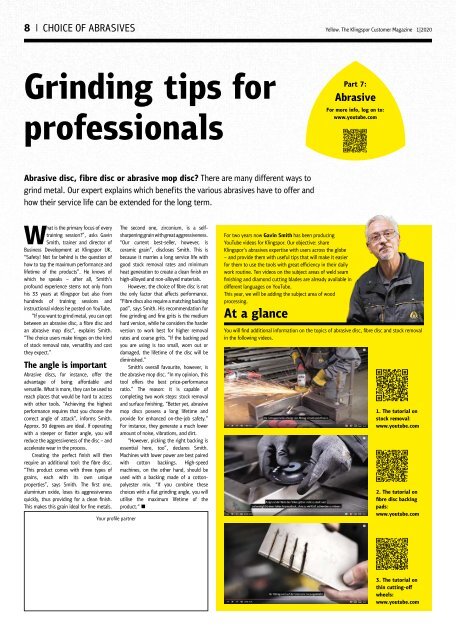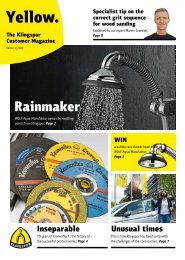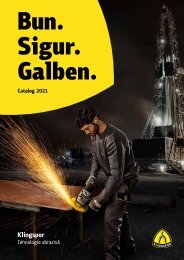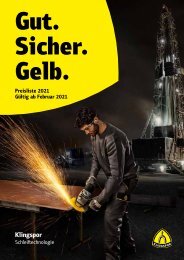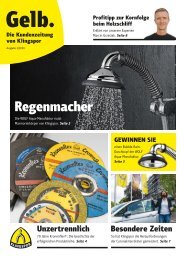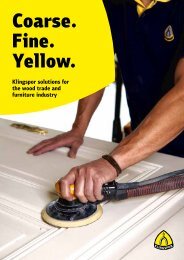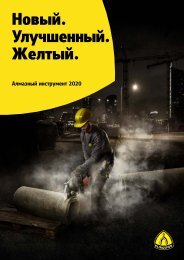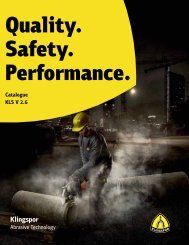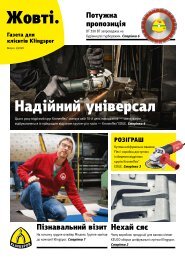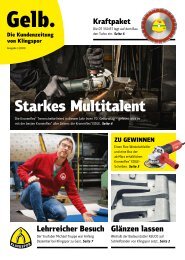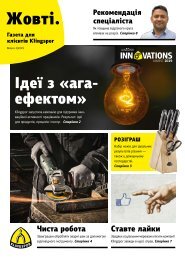Yellow. The Klingspor customer magazine - Edition 1|2020
The new Klingspor customer magazine!
The new Klingspor customer magazine!
You also want an ePaper? Increase the reach of your titles
YUMPU automatically turns print PDFs into web optimized ePapers that Google loves.
8 CHOICE OF ABRASIVES<br />
<strong>Yellow</strong>. <strong>The</strong> <strong>Klingspor</strong> Customer Magazine <strong>1|2020</strong><br />
Grinding tips for<br />
professionals<br />
Part 7:<br />
Abrasive<br />
For more info, log on to:<br />
www.youtube.com<br />
Abrasive disc, fibre disc or abrasive mop disc? <strong>The</strong>re are many different ways to<br />
grind metal. Our expert explains which benefits the various abrasives have to offer and<br />
how their service life can be extended for the long term.<br />
What is the primary focus of every<br />
training session?”, asks Gavin<br />
Smith, trainer and director of<br />
Business Development at <strong>Klingspor</strong> UK.<br />
“Safety! Not far behind is the question of<br />
how to tap the maximum performance and<br />
lifetime of the products”. He knows of<br />
which he speaks – after all, Smith's<br />
profound experience stems not only from<br />
his 33 years at <strong>Klingspor</strong> but also from<br />
hundreds of training sessions and<br />
instructional videos he posted on YouTube.<br />
“If you want to grind metal, you can opt<br />
between an abrasive disc, a fibre disc and<br />
an abrasive mop disc”, explains Smith.<br />
“<strong>The</strong> choice users make hinges on the kind<br />
of stock removal rate, versatility and cost<br />
they expect.”<br />
<strong>The</strong> angle is important<br />
Abrasive discs, for instance, offer the<br />
advantage of being affordable and<br />
versatile. What is more, they can be used to<br />
reach places that would be hard to access<br />
with other tools. “Achieving the highest<br />
performance requires that you choose the<br />
correct angle of attack”, informs Smith.<br />
Approx. 30 degrees are ideal. If operating<br />
with a steeper or flatter angle, you will<br />
reduce the aggressiveness of the disc – and<br />
accelerate wear in the process.<br />
Creating the perfect finish will then<br />
require an additional tool: the fibre disc.<br />
“This product comes with three types of<br />
grains, each with its own unique<br />
properties”, says Smith. <strong>The</strong> first one,<br />
aluminium oxide, loses its aggressiveness<br />
quickly, thus providing for a clean finish.<br />
This makes this grain ideal for fine metals.<br />
Your profile partner<br />
<strong>The</strong> second one, zirconium, is a selfsharpening<br />
grain with great aggressiveness.<br />
“Our current best-seller, however, is<br />
ceramic grain”, discloses Smith. This is<br />
because it marries a long service life with<br />
good stock removal rates and minimum<br />
heat generation to create a clean finish on<br />
high-alloyed and non-alloyed materials.<br />
However, the choice of fibre disc is not<br />
the only factor that affects performance.<br />
“Fibre discs also require a matching backing<br />
pad”, says Smith. His recommendation for<br />
fine grinding and fine grits is the medium<br />
hard version, while he considers the harder<br />
version to work best for higher removal<br />
rates and coarse grits. “If the backing pad<br />
you are using is too small, worn out or<br />
damaged, the lifetime of the disc will be<br />
diminished.”<br />
Smith’s overall favourite, however, is<br />
the abrasive mop disc. “In my opinion, this<br />
tool offers the best price-performance<br />
ratio.” <strong>The</strong> reason: it is capable of<br />
completing two work steps: stock removal<br />
and surface finishing. “Better yet, abrasive<br />
mop discs possess a long lifetime and<br />
provide for enhanced on-the-job safety.”<br />
For instance, they generate a much lower<br />
amount of noise, vibrations, and dirt.<br />
“However, picking the right backing is<br />
essential here, too”, declares Smith.<br />
Machines with lower power are best paired<br />
with cotton backings. High-speed<br />
machines, on the other hand, should be<br />
used with a backing made of a cottonpolyester<br />
mix. “If you combine these<br />
choices with a flat grinding angle, you will<br />
utilise the maximum lifetime of the<br />
product.“ ■<br />
For two years now Gavin Smith has been producing<br />
YouTube videos for <strong>Klingspor</strong>. Our objective: share<br />
<strong>Klingspor</strong>'s abrasives expertise with users across the globe<br />
– and provide them with useful tips that will make it easier<br />
for them to use the tools with great efficiency in their daily<br />
work routine. Ten videos on the subject areas of weld seam<br />
finishing and diamond cutting blades are already available in<br />
different languages on YouTube.<br />
This year, we will be adding the subject area of wood<br />
processing.<br />
At a glance<br />
You will find additional information on the topics of abrasive disc, fibre disc and stock removal<br />
in the following videos.<br />
1. <strong>The</strong> tutorial on<br />
stock removal:<br />
www.youtube.com<br />
2. <strong>The</strong> tutorial on<br />
fibre disc backing<br />
pads:<br />
www.youtube.com<br />
3. <strong>The</strong> tutorial on<br />
thin cutting-off<br />
wheels:<br />
www.youtube.com


